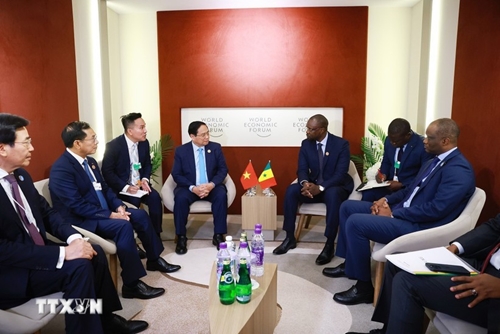Dang traced the relationship back to shared colonial histories, struggles for independence, and membership in the International Organization of La Francophonie (OIF), where Senegal is a founding member.
    |
 |
|
At a meeting between Vietnamese Prime Minister Pham Minh Chinh and his Senegalese counterpart Ousmane Sonko |
He also noted people-to-people links, including Senegalese citizens of Vietnamese descent, symbolizing enduring fraternal ties. Vietnamese martial arts, especially Viet Vo Dao, have recently gained popularity in Senegal, further strengthening cultural exchange.
The Senegalese official emphasized the role of National Assemblies as bridges between the peoples and welcomed initiatives like the proposed Vietnam–Senegal Parliamentary Friendship Group, encouraging expanded inter-parliamentary dialogue and cooperation in multilateral forums.
On economic ties, Dang noted a 52.4% increase in bilateral trade in 2023 compared to 2022. In the first four months of 2025, Vietnam exported to Senegal 43.43 million USD worth of goods, nearing the figure in the whole 2024.
Vietnam now supplies about 10% of Senegal’s rice demand, with rice making up nearly 60% of Vietnamese exports, while Senegal exports primarily raw cashew nuts (87% of exports to Vietnam), fishmeal, seafood, and seeds. This trade exemplifies successful South–South cooperation based on mutual benefit, he said.
He outlined Senegal’s “Vision Senegal 2050,” focusing on four pillars - mining industries (oil, gas, phosphates), agro-product processing, manufacturing, and high-value services such as digital technology, tourism, and creative industries. These are sectors Senegal wishes to promote cooperation with Vietnam, he said.
In digital development, Senegal’s “New Deal Technologique” strategy aims to establish the country as a regional digital hub, prioritizing digital sovereignty, e-government, and tech-sector leadership. Dang proposed high-level dialogue between Vietnamese and Senegalese officials, including a ministerial technology meeting to boost collaboration.
Agricultural research is another strategic focus. Dang highlighted cooperation between Senegal’s Institute for Agricultural Research (ISRA) and Vietnam’s Academy of Agricultural Sciences (VAAS) to improve soil quality, farming techniques, and food security, underpinning Senegal’s ambition to build an innovative agricultural ecosystem.
With over 75% of its population under 35 and a median age of 19, Senegal prioritizes education and vocational training. Dang stressed the importance of partnering with Vietnam to support human capital development essential for long-term growth.
Senegal also promotes sustainable regional growth hubs, welcoming the twinning of Ziguinchor (Senegal) and Can Tho (Vietnam) as a model of decentralized cooperation.
A series of memoranda of understanding on agriculture, trade, and transport are institutionalizing bilateral ties, with a draft inter-parliamentary agreement expected to facilitate investment and sustain dialogue.
Regarding regional strategy, Dang sees Vietnam as a crucial ASEAN partner with strong economic dynamism that can help Senegal connect with Asian markets and attract investment. Conversely, Senegal offers Vietnam and ASEAN a strategic gateway to West Africa, with a young population, rich resources and economic potential.
Looking forward, Dang expressed confidence that the shared cultural affinity, economic complementarity, and values between Vietnam and Senegal will deepen and diversify cooperation across sectors.
Source: VNA